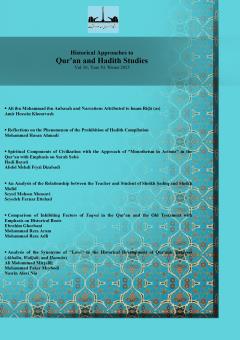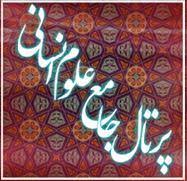About the journal
Recent Articles
-
Open Access Article
1 - Journal ID, Criteria for Writing Articles and List of Journal Articles
Issue 81 , Vol. 30 , Winter 2025 -
Open Access Article
2 - Ali ibn Mohammad ibn Anbasah and Narrations Attributed to Imam Riḍā (as)
Amir Hasan Khorvash *Issue 81 , Vol. 30 , Winter 2025 -
Open Access Article
3 - Reflections on the Phenomenon of the Prohibition of Hadith Compilation
Mohammad Hassan Ahmadi *Issue 81 , Vol. 30 , Winter 2025 -
Open Access Article
4 - Spiritual Components of Civilization with the Approach of “Monotheism in Actions” in the Qur’an with Emphasis on Surah Sabá
Hadi Bayati * ، Abdol Mehdi Feyzi DizabadiIssue 81 , Vol. 30 , Winter 2025 -
Open Access Article
5 - An Analysis of the Relationship between the Teacher and Student of Sheikh Ṣadūq and Sheikh Mofīd
Seyed Mohsen Mousavi * ، Seyedeh Farnaz EttehadIssue 81 , Vol. 30 , Winter 2025 -
Open Access Article
6 - Comparison of Inhibiting Factors of Taqwá in the Qur'an and the Old Testament with Emphasis on Historical Roots
Ebrahim Ghorbani ، Mohammad Reza Aram * ، Mohammad Reza AdliIssue 81 , Vol. 30 , Winter 2025 -
Open Access Article
7 - Analysis of the Synonyms of "Love" in the Historical Development of Qur'anic Exegeses (Akhdān, Walījah, and Ḥannān)
Ali Mohammad Mir Jalili ، Mohammad Faker Meybodi ، Nasrin Alavi Nia *Issue 81 , Vol. 30 , Winter 2025 -
Open Access Article
8 - English Translation of Article Abstracts, Journal ID and English List of Journal Articles
Issue 81 , Vol. 30 , Winter 2025
Most Viewed Articles
-
Open Access Article
1 - The Concept of Historicity and Its Role in the Issuance Causes of Conflicting Narratives
Behrooz Fadaei Rad ، Mohammad Nasehi * ، Hosein Khoshdel MofradIssue 78 , Vol. 30 , Spring 2024 -
Open Access Article
2 - Historical Analysis of al-Wasīlah Sermon and al-Ṭālūtīyah Sermon
Sayyed Mohammad Moosavinassab Mobarakeh ، Amidreza Akbari * ، Asghar Montazerol GhaemIssue 78 , Vol. 30 , Spring 2024 -
Open Access Article
3 - Narrative-Rijāli Personality of Mohammad ibn Isa ibn Ubaid with Emphasis on His Herritage in »Kashī's Rijāl«
Kowsar Yousefi Najaf Abadi ، Hosein Sattar * ، Rouhollah Shahidi ، Mohammad Hadi Yousefi GharaviIssue 78 , Vol. 30 , Spring 2024 -
Open Access Article
4 - Determining the Origin of the Assimilation of Jesus and Mahdi with the Dating of Narratives
Ensieh al-Sadat Eskaf ، Nosrat Nil Saz * ، Kazem Ghazi Zadeh ، Hosein Khandagh AbadiIssue 78 , Vol. 30 , Spring 2024 -
Open Access Article
5 - Dating of Surah Ṭāhā Based on the Concept of Emigration in the Story of Prophet Moses (as)
Fatemeh Sanei ، Davood Esmaili * ، Amir Ahmad NejadIssue 78 , Vol. 30 , Spring 2024 -
Open Access Article
6 - Reflecting the Changes of Iranian-Islamic Culture in the Data of Social History; A Case Study of Hadiths of Musnad al-Riḍā (as)
Azam Javadi ، Alireza Ashtari Tafreshi *Issue 78 , Vol. 30 , Spring 2024 -
Open Access Article
7 - Journal ID and Table of Contents and Criteria for Writing Journal Articles
Issue 78 , Vol. 30 , Spring 2024 -
Open Access Article
8 - English translations of abstracts of journal articles and journal ID in English
Issue 78 , Vol. 30 , Spring 2024 -
Open Access Article
9 -
مجید چهری *Issue 57 , Vol. 21 , Summer 1394 -
Open Access Article
10 -
سیفعلی زاهدی فر * ، آمنه موسوی شجریIssue 56 , Vol. 20 , Winter 1393









